The climate of Kyoto
The climate of Kyoto if often very mind and humid during the spring and summer months. It is also rainy during the summertime because of its tropical location. The heat island effect contributes a lot to the temperature of the city. The maximum temperature that the city will reach it around 95 degrees Fahrenheit, and rarely exceeded 100 degrees. The nights are often very high in humidity, and monsoon season adds to that value. The winters are mild with highs over 50 degrees Fahrenheit. Their isn’t a lot of snow, just light flurries and cold rain.
 The threats that climate change has on Kyoto
The threats that climate change has on Kyoto
Kyoto is a coastal city on the west side of Japan has been around for 1200 years. The main problems that they encounter have to do hurricanes, and the aftereffects of flooding. Some other natural disasters that can happen there are typhoons and occasional earthquakes. Kyoto lies on two fault lines which is the Hanaore fault, and the Nara Basin Toen fault. When they have earthquakes, they are generally rather large ones because of the fact of the location of where the city sits.
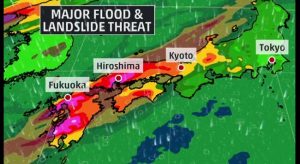
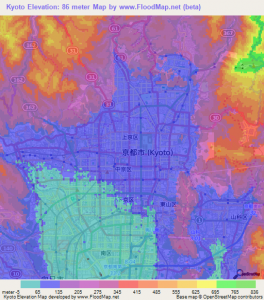
Natural disaster public awareness
Japan is prone to natural disasters and has over the years created an advanced warning system that is quick and informs the public. A problem that the old warning system had was to make people think that taking shelter in any infrastructure was safe (false sense of security), but in reality they were not. With the new warning system is can figure out where the best locations are to seek shelter. The improvement of this system has saved countless lives and the social aspect of the communities. In areas severely treated by natural disasters, some of the communities don’t partake in drills to prepare for flooding and major storm events, so Japan is trying to figure out ways to reach out to them and convince those communities that it is in their best benefit to do so. The graph below shows how prepared Japan is for natural disasters compared to other countries.
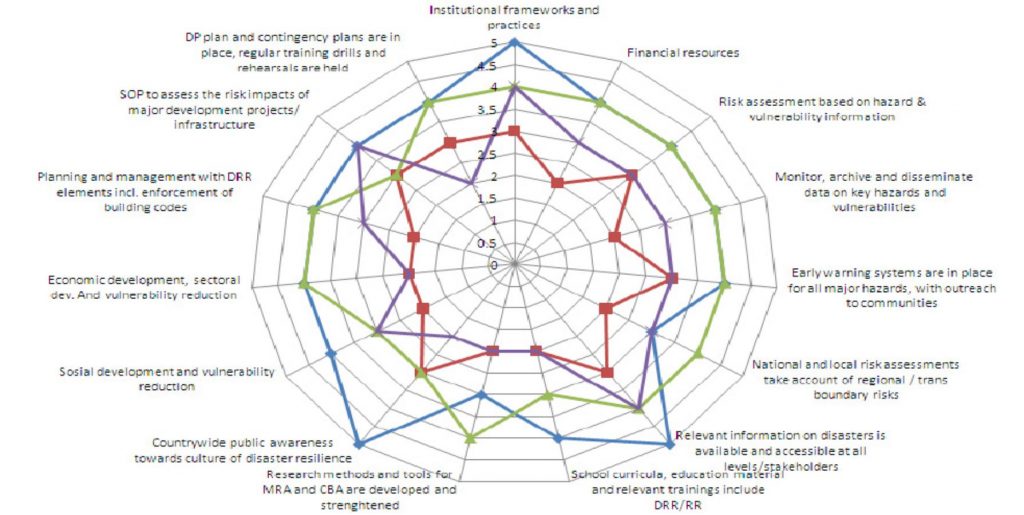
What steps are the city of Kyoto taking to mitigate?
The City of Kyoto Is proud of its history with dealing with these events. The government is implementing green economy and a city-wide collaboration in dealing with climate change. The country of Japan has always given financial support to all the cities that are in it. Every year Japan puts 500,000 dollars to the IDNDR Trust Fund, and this is to help specifically for any type of natural disaster. The Japan Disaster Relief Program (JDR) is a team funded by the government to go out into major disaster areas to do primarily search and rescue missions. They service Kyoto when these natural occurrences happen. (sources of funding)
Other fundraisers helping in Kyoto include:
Idro Japan (Accepts Volunteer and donates to the cause)
It’s Not Just Mud (A volunteer service for disaster relief)
Japanese Red Cross (Donates a good amount of money, and is always accepting volunteers)
Japan National Council of Social Welfare (Shows a list of organizations that contribute money and volunteers)
Donation for Western Japan Heavy Rain (Donations from Rakuten Points, credit card or bank transfers)
AAR Japan (Has emergency response teams ready and accept donations)
Yahoo! Japan (Collects donation which is sent directly to disaster relief programs)
Peace Winds Japan ((Has a Campfire Account (similar to GoFundMe) that goes directly to relevant municipal government))
Open Japan KEEN Matching Pay (Partnered with KEEN footwear to match all donations for a month. They already have volunteers on ground already)
Janic (Provides a list of organizations for disaster relief)
 How Is the city adapting infrastructures to respond to climate change?
How Is the city adapting infrastructures to respond to climate change?
Kyoto is considered a pilot study project for Cities Alive and has a section talking about how they are making their buildings more resilient. The city is working on improving their water supply, sewage, and Storm Water management assets to keep the city moving. The 100 Resilient Cities website, they mention that they have 66 projects lined up as of 2016 to improve buildings and create greener infrastructure to use the water to their advantage. The Kyoto Protocol implemented UNFCCC, which is an organization to combat greenhouse gas going into our atmosphere. They plan on being completely free of building and vehicle emissions by the year 2050. It will surely be a challenge, but something they would really like to see done.
 What is the Kyoto Protocol?
What is the Kyoto Protocol?
The Kyoto Protocol is an agreement signed by 128 nations around the world to help control climate change and their mission was to reduce greenhouse gasses by 5%. They are most concerned about the rising temperature and how it causes so many deaths worldwide from malaria, malnutrition, and diarrhea, which all together cause 3.5 million deaths a year from temperature and toxic rain changes. The Paris Agreement soon took place after this to continue this global challenge.

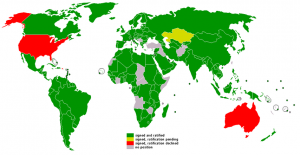
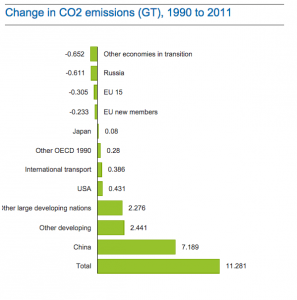
How are youth included?
The city is suffering from an aging population where there is a lack of middle age men and woman. So, it is up to the kids to figure out what they need in order to grow. Occasionally the planning committee has events for kids to participate by giving them ideas for what they can improve on. They strongly believe that the future lies with the kids. The Kyoto Protocol addresses this in its statement. They play a crucial role in helping improve the city with climate change in mind. The kids were asked to do a questionnaire-based pilot survey, and the scores were off the chart for what they knew about climate change. Among them; 66% were male, and 33.8% were females in different study areas. Now with these kids, in total 98.5% of the kids said through the survey that they believed climate change is real. Then 95.5% said human activities contribute to climate change as well. These are high numbers, and it means a whole lot that the kids are aware of this so that they can help make these good decisions and are educated enough on the matter. The youth are being educated all throughout their k-12 schooling, and it is a strong tool for combating destructive potential of climate change. The children can make a decision, and when they are older play a huge role in helping these changes come to life. With the declining age population that I said before, there are fewer people to support the economy, and to increase the power of reliance to overcome the climate issue. This was a recent issue that the Mayor, Daisaku Kadokawa addressed in March of 2019 at a climate change conference.
Leave a Reply